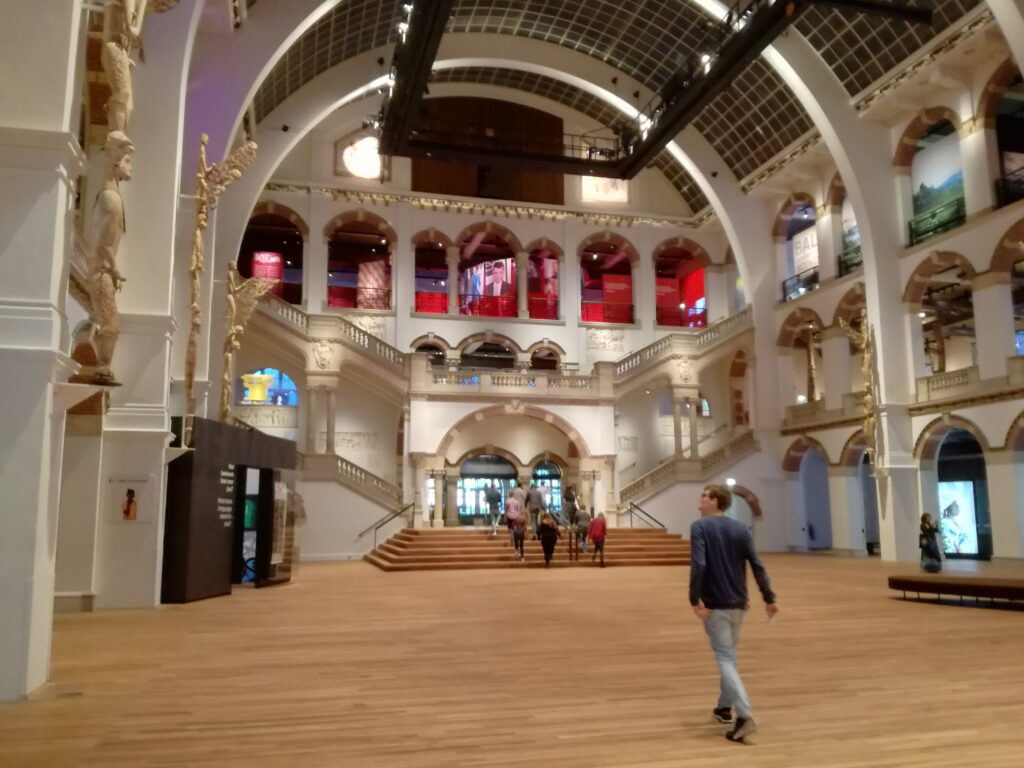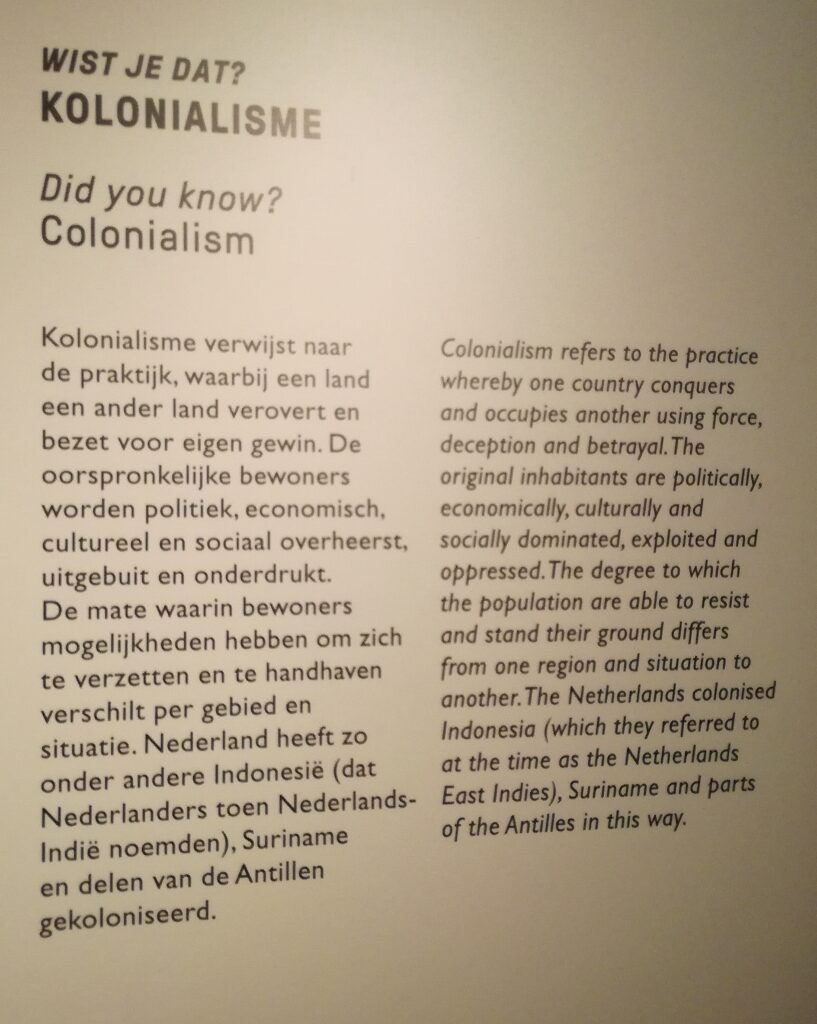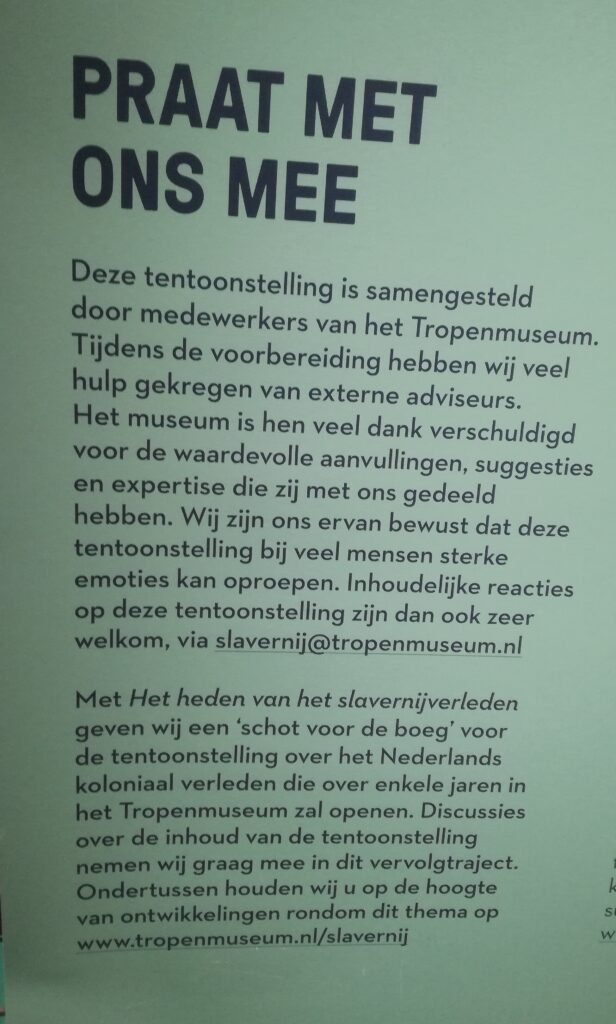Kiki Ernst

The original goal when visiting the Tropenmuseum was to see their exhibition ‘Genderful World’. However, when climbing the stairs to the top floor something else caught my attention, stopping me in my tracks. A tv screen was showing a Dutch, black spoken word artist talking about the way the Dutch history of slavery still affected him and his family to this day. I stood there listening for a while before I realised the rest of the group had already continued on upstairs. After following them up and going through the exhibition we had originally travelled to Amsterdam for, myself and a couple of other students decided to go take a good look at the exhibition we had spotted earlier.
For about a year now the Tropenmuseum in Amsterdam has housed this exhibition about slavery. The exhibition is called Heden van het slavernijverleden (History of Slavery in the Present). It includes both historical accounts of the Dutch slave trade, and art pieces from contemporary black artists. This exhibition is about the impact of the Netherlands’ history of slavery and how this history still impacts Dutch society to this day.

The first thing we noticed when reading the information put up by the museum is that they were not trying to be vague, overly polite or watering down the issue. They faced this difficult topic head on, recognising the how the trauma of this past is still passed on through generations of black families in the Netherlands. This is an issue often ignored by big institutions. Museums and the like are still a majority white-run organisations that don’t always know how to tackle certain topics. This results in them either ignoring the topic completely, or not addressing specific aspects of it. They may think that omitting certain stuff is better than accidentally saying something wrong, or that it is their way of maintaining ‘neutrality’, while in actuality it feels more like gaslighting. I think museums should be prepared to tackle difficult subjects and willing to reach out to people who are more knowledgeable to help them out.
Looking at reviews online you can tell that the response to the exhibition was very positive. The is-it-really-still-that-big-a-deal style reviews were few and hard to find. Veerle Driessen wrote an article for the NRC this week about how museums should no longer pretend that neutrality is achievable. I think her voice is indicative of a new generation, calling for museums and other institutions to recognise their own bias. At this point whenever a museum or academic pretends that they are above mixing their personal opinions with their work, it just feels childish. We’re at a point now where we are children finally realising that our parents are not all-knowing beings, but they too are just human. I feel the exhibition at the Tropenmuseum encapsulates this very well.
In being aware of their own biases, the Tropenmuseum also explicitly calls for visitors’ input about the contents of the exhibition. There are signs encouraging people to send e-mails with critique, or if they have a story/object they would like to add to the exhibition. I really enjoyed seeing this willingness to recieve public feedback. Still, it was unclear how much of the feedback they had gotten in the previous year had actually been implemented and in which way. On there website there also wasn’t anything about this, sadly. I would encourage them to share this process of critique and how they incorporate it. I would not add it to the exhibition, but it would be nice to see something about it on the website.

What impressed me most about the exhibition is how well they managed to amplify black voices, both contemporary and from the past. Museums, and any white institution, and also a lot of white people, have a tendency to talk for and over the group they supposedly want to give a voice. This is an issue we saw as well this year with the #blackout trend on Instagram, where a lot of non-black Instagram users were flooding their feats with black squares in support of the Black Lives Matter protests, while black communities were trying to explain to them that this wasn’t helping at all. By flooding everyone’s feed with black squares, they were drowning out black voices. Being silent was pretty much the least helpful thing people could do. Sharing information, calling attention to black influencers and creators, that had actual potential to make some kind of impact. Tropenmuseum seems to have understood this concept, as their exhibition shares stories told by black people, and also literally let contemporary artists speak.
While taking a clear stance on the issue on the Dutch history of slavery, and presence of structural racism, they did apply a level of historical nuance. Between the stories of people who had been made slaves, and tales about white slave owners, we also encounter the complex topic of black slave owners. The museum included the story of one woman in the U.S. who had her own plantation, even though her family had lived their lives being treated as property. They didn’t use this as an argument for or against anything, but simply included it as one of the many stories. They also addressed the issues of the black slave owners who sold people from neighbouring tribes and kingdoms to the Dutch. Here the museum both recognised that this happened, which many don’t (looking at you Zwart in Rembrandthuis), while also explaining how the Dutch actually encouraged and instigated more violence between communities to increase their own profits.
Overall I would recommend everyone to visit this exhibition. It is gripping and interesting, while also being historical and nuanced. A true breath of fresh air.
https://www.tropenmuseum.nl/nl/zien-en-doen/tentoonstellingen/heden-van-het-slavernijverleden